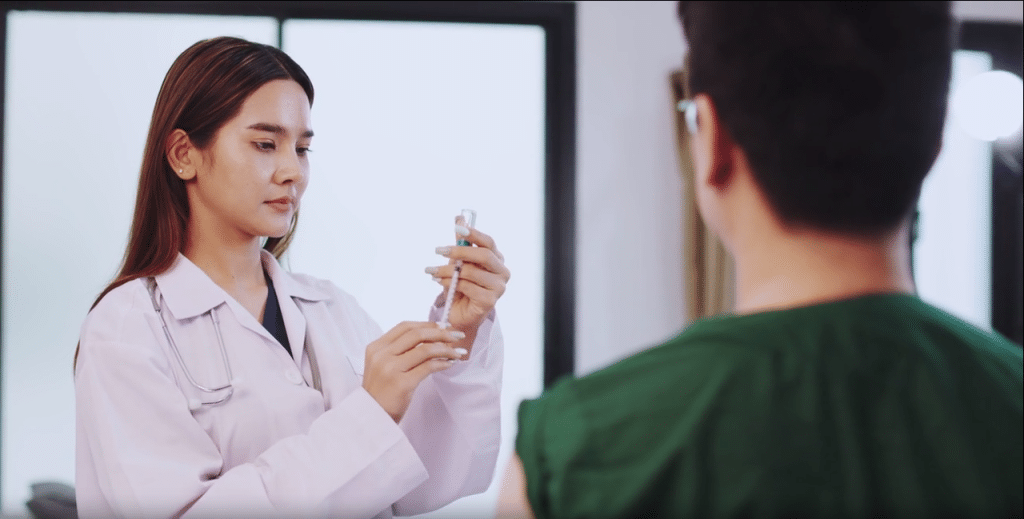Imagine a world where baldness is as obsolete as dial-up internet. Recent advancements in stem cell research suggest we might be inching closer to this reality. Stem cells, those mysterious entities with the power to transform into various cell types, are being eyed as the next big thing in hair regrowth. But can they really turn the tide in the battle against hair loss? As we delve into the science, the potential treatments, and the evidence, one can’t help but be intrigued by the possibilities. The future of hair restoration could be here, but are we ready to embrace it?
Key Takeaways
- Stem cell therapy has the potential to stimulate dormant hair follicles, promoting hair regrowth.
- Clinical studies support the efficacy of stem cells in halting hair loss and stimulating follicle growth.
- Potential risks of stem cell therapy include infection and improper cell differentiation, and its long-term effects are still under investigation.
- Future prospects in stem cell research offer promising solutions for hair loss, despite challenges in scalability and affordability.
Learn more about our Stem Cell Therapy
Understanding the Science: How Stem Cells May Regrow Hair
To grasp how stem cells can regrow hair, it’s essential to first understand what stem cells are and their function in hair regrowth. Next, we’ll explore the role of adult stem cell therapy in the regeneration of hair follicles. Lastly, we’ll compare the advantages of using stem cells over traditional hair loss treatments.
What Are Stem Cells and How Do They Work for Hair Regrowth?
Stem cells, often hailed as the body’s master cells, hold immense potential for hair regrowth because of their ability to transform into any cell type. This is the foundation of stem cell therapy for hair loss. It’s no wonder people are searching for ‘stem cell therapy near me’ or ‘stem cell hair treatment’. The benefits of stem cells lie in their regenerative abilities, a cornerstone in regenerative medicine near me.
Stem cell supplements aid this process, with many touting stem cell supplements benefits. Likewise, stem cell treatment near me is gaining popularity. Techniques like stem cell infusion offer hope, and adult stem cell therapy shows promise in addressing hair loss.
| Method | Pros |
|---|---|
| Stem Cell Therapy | Potential for hair regrowth |
| Stem Cell Supplements | Aid regenerative process |
| Stem Cell Infusion | Offers hope |
| Adult Stem Cell Therapy | Shows promise |
| Regenerative Medicine | Uses stem cells |
The Role of Adult Stem Cell Therapy in Hair Follicle Regeneration
Delving into the science behind it, adult stem cell therapy plays a significant role in regenerating hair follicles, potentially paving the way for effective hair regrowth solutions. The therapy involves the extraction of stem cells, usually from the patient’s own body, which are then multiplied in a lab setting.
Once enough cells are grown, they’re injected into the scalp, where they work to rejuvenate the hair follicles. It’s the adult stem cells’ unique ability to differentiate into various types of cells that makes this possible. They can transform into cells that make up the hair follicle, fostering a conducive environment for hair regrowth. While this innovative method isn’t a guaranteed cure for all types of hair loss, it’s an exciting development in the field of regenerative medicine.
Benefits of Stem Cells Compared to Traditional Hair Loss Treatments
In comparing stem cell therapy to traditional hair loss treatments, it’s clear that this innovative approach offers several compelling benefits. Unlike typical solutions which slow down hair loss or at best, partially restore it, stem cell therapy has the potential to regenerate healthy hair follicles, leading to natural, lasting regrowth. It’s a more direct, biological solution that addresses the root cause of hair loss.
Furthermore, it’s less invasive than hair transplant surgeries and doesn’t involve any artificial or chemical agents, eliminating side effects associated with them. While there’s still much to learn about stem cell therapy for hair loss, it’s evident that this technique’s benefits could revolutionize the way we combat hair loss in the future.

Exploring Stem Cell Hair Treatment Options
Now that the science behind how stem cells may regrow hair has been explained, it’s time to explore the various stem cell hair treatment options. From discussing what one can expect from a treatment session, to explaining how stem cell infusion rejuvenates the scalp, this section will provide a comprehensive overview. It will also guide individuals on how to find reliable stem cell treatment providers in their vicinity.
What to Expect from a Stem Cell Hair Treatment Session
When considering stem cell hair treatment, it’s important to know what to expect during a session. Typically, it begins with a consultation where the doctor assesses the patient’s condition and discusses the procedure. This is followed by the harvesting of stem cells, usually from the patient’s own body. Then, the cells are prepared for transplantation. Finally, the stem cells are injected into the scalp to stimulate hair growth.
Here’s a quick breakdown:
| Steps | Description | Duration |
|---|---|---|
| Consultation | Discussion with the doctor | 30-60 mins |
| Harvesting | Collecting stem cells | 1-2 hrs |
| Preparation | Preparing cells for transplant | 1 hr |
| Transplantation | Injecting cells into scalp | 1-2 hrs |
How Stem Cell Infusion Is Used in Scalp Rejuvenation
Stem cell infusion, a groundbreaking approach to scalp rejuvenation, harnesses the body’s own regenerative potential to combat hair loss. In this procedure, stem cells are first harvested from the patient’s body, typically from fat tissue or bone marrow. These cells are then processed and introduced into the scalp.
Much like a conductor leading an orchestra, these stem cells direct and enhance the body’s natural repair process. They stimulate dormant hair follicles, reinvigorating the scalp’s ability to produce healthy hair.
While not a quick fix, the results are promising. Over time, patients can expect to see a gradual increase in hair density and thickness. It’s an innovative solution that’s giving hope to those who’ve tried everything else.
Finding a Reliable Stem Cell Treatment Near Me
After understanding the potential benefits of stem cell treatment for hair loss, it’s natural to wonder about finding a reputable clinic that offers this innovative service. The process can be overwhelming but it’s vital to prioritize certain factors to ensure high-quality treatment.
- Experience: A clinic with a proven track record in stem cell therapy is crucial. This shows they’ve successfully performed the procedure numerous times, honing their skills and expertise.
- Certification: Ensure the clinic is certified by relevant health authorities. This guarantees they meet the required standards and regulations.
- Patient Reviews: Look for clinics with positive feedback from previous clients. This provides firsthand insight into their service quality, professionalism and success rates.
Securing a reliable clinic can help transform hair loss woes into a rejuvenating journey.
Results and Research: What Does the Evidence Say?
Let’s now turn our attention to the evidence and research results related to stem cells for hair loss. We’ll examine clinical studies, real patient outcomes before and after therapy, and the potential long-term benefits of stem cell therapy for hair restoration. Each point offers a unique perspective on the efficacy and potential of this treatment.
Clinical Studies on Stem Cells for Hair Loss
Numerous clinical studies have explored the potential of stem cells in treating hair loss, yielding diverse and intriguing findings. Research has consistently demonstrated that stem cells can stimulate the growth of hair follicles, the tiny organs that grow and sustain our hair.
1) One groundbreaking study found that hair follicles in bald patches of skin still had their stem cells intact. This suggests that hair loss may be reversed by reactivating these dormant cells.
2) Another research revealed that stem cells can be used to produce new hair follicles. This could potentially lead to treatments that not only halt hair loss, but also regrow hair in those who’ve completely lost it.
3) A third study has shown that stem cells can regenerate hair in mice. While not directly applicable to humans, it offers a promising glimpse into the future of hair loss treatments.

Real Patient Outcomes: Before and After Stem Cell Therapy
Delving into real patient outcomes, it’s clear that stem cell therapy has brought about significant changes in hair growth patterns, with before and after images serving as compelling evidence. Patients, previously battling stubborn hair loss, have seen dramatic transformations, often with a fuller, thicker head of hair. In several cases, thin, sparse areas have been replenished with dense growth.
Experts attribute these outcomes to the therapy’s ability to stimulate dormant hair follicles, renewing their productivity. However, it’s worth noting that results vary, depending on factors such as the individual’s overall health, age, and the treatment’s frequency and consistency. Despite these variables, the evidence suggests stem cell therapy’s potential in addressing hair loss, inciting hope for those struggling with this common issue.
Long-Term Benefits of Stem Cell Therapy Near Me for Hair Restoration
Research into stem cell therapy for hair restoration reveals substantial long-term benefits, with evidence pointing to sustained hair growth and density. The effectiveness of this treatment relies on the body’s regenerative capacity, stimulated by the introduction of stem cells.
Here are three compelling reasons to consider stem cell therapy for hair restoration:
- Enduring Results: Unlike topical treatments or medications that require continuous use, stem cell therapy offers lasting results. This means less time worrying about hair loss and more time enjoying your renewed confidence.
- Natural-Looking Hair: Stem cells promote the growth of your own hair, ensuring a seamless and natural appearance.
- Improved Scalp Health: Beyond hair growth, stem cells can also rejuvenate the scalp, potentially reducing issues such as dandruff or dryness.
Enhancing Results with Supplements and Regenerative Care
While stem cells are a promising treatment for hair loss, pairing them with supplements and regenerative care may optimize results. This section will explore whether natural hair growth can be boosted by stem cell supplements. It will also discuss the wider benefits of these supplements and the advantages of combining treatments with local regenerative medicine for a holistic approach.
Stem Cell Supplements: Do They Boost Hair Growth Naturally?
Stem cell supplements are emerging as a potential natural solution for boosting hair growth, and their use in conjunction with regenerative care is attracting considerable interest. These supplements, often made from natural ingredients like antioxidants, vitamins, and other nutrients, aim to nourish the scalp and hair follicles, thereby stimulating hair growth.
Let’s consider three key reasons why stem cell supplements may be the hair growth solution you’ve been seeking:
- Natural Solution: They offer a potentially safer, more natural method for hair restoration without the need for invasive surgical procedures or chemically-laden products.
- Convenience: Easy to incorporate into your daily routine, stem cell supplements could provide a hassle-free approach to hair growth.
- Complement to Regenerative Care: When used with regenerative therapies, these supplements may boost outcomes, leading to fuller, healthier hair.
Stem Cell Supplements Benefits for Hair, Skin, and Beyond
Beyond just promoting hair growth, stem cell supplements can also provide remarkable benefits for the skin and overall health, particularly when combined with regenerative care. They’re known to enhance skin elasticity and hydration, reducing wrinkles and signs of aging. As the body ages, the number of stem cells decreases, leading to slower cellular regeneration.
By supplementing with stem cells, one can boost the body’s ability to repair and renew tissues. This isn’t limited to skin and hair; it also includes vital organs and systems. Hence, the advantages of stem cell supplements extend to general well-being, potentially improving immune response, energy levels, and cognitive function. It’s clear that these supplements aren’t just beauty aids, but powerful tools for holistic health.
Pairing Treatments with Regenerative Medicine Near Me for Holistic Results
To achieve holistic health results, it’s essential to pair stem cell supplements with regenerative medicine treatments. This combination offers a comprehensive approach to hair loss, targeting both internal and external factors.
- Stem cell supplements: They’re designed to enhance the body’s natural regeneration processes. Supplements can bolster your body’s ability to restore damaged tissues, including hair follicles.
- Regenerative medicine treatments: These treatments, such as platelet-rich plasma therapy, use your body’s own cells to stimulate hair growth.
- Holistic care: Combining these treatments with a balanced diet and healthy lifestyle can produce optimal results.
Cost, Risks, and Considerations Before Starting Treatment
Taking the plunge into stem cell treatments for hair loss requires careful consideration. One must weigh the safety of the procedure and understand the potential risks involved. Additionally, the cost of the therapy and the choice of provider can significantly impact the decision-making process.

Is Stem Cell Hair Treatment Safe? Risks to Know About
Before opting for stem cell hair treatment, it’s crucial to understand the potential risks associated with this procedure.
- Infection risk: Like any medical procedure, there’s a chance of infection. The procedure involves injections, which, if not done correctly, could lead to infections.
- Unpredictable results: While stem cell therapy promises hair growth, the results can vary greatly from person to person. Some may experience substantial hair regrowth, others may see little to no change.
- Potential for growth in unwanted areas: There’s a possibility that the injected stem cells could cause hair growth in unwanted areas.
It’s essential to weigh these risks against the potential benefits before deciding on this treatment. Remember, it’s always best to consult with a healthcare professional.
Cost Breakdown of Stem Cell Therapy Near Me for Hair Loss
After weighing the potential risks, it’s time to consider the financial aspect of stem cell therapy for hair loss. Prices can vary greatly, usually ranging from $4,000 to $10,000 per treatment. It’s important to remember that health insurance often doesn’t cover this therapy as it’s considered experimental. Patients must factor in multiple sessions since one treatment isn’t usually enough.
Other costs include follow-up appointments and potential medications. It’s also advisable to consider indirect costs such as time off work for recovery. These expenses should be weighed against the potential benefits and compared to traditional hair restoration methods. It’s crucial to fully understand the financial commitment before embarking on this journey.
How to Choose a Provider for Regenerative or Stem Cell Therapy Near Me
In choosing a provider for stem cell therapy, it’s crucial to consider not only the cost but also the potential risks and necessary considerations before starting treatment. Making an informed decision requires adequate research and a careful weighing of options.
- Reputation and Experience: Always choose a provider with a solid reputation and years of experience in stem cell therapy. Their track record can offer assurance of their expertise.
- Patient Testimonials: Feedback from previous patients can provide insights into the provider’s practice. Negative experiences shouldn’t be ignored.
- Transparent Costing: The provider should offer a clear breakdown of treatment costs, avoiding hidden charges.
Interested in learning more? Follow us
Conclusion
While the idea of using stem cells to regrow hair may seem outlandish, emerging research and treatment options show promise. It’s not a quick fix, but combined with supplements and regenerative care, it could pave the way for future hair loss solutions. Yes, it’s costly and not without risks, but for many, the potential to restore a full head of hair may outweigh concerns, offering a glimmer of hope in the face of hair loss.
Frequently Asked Questions
Do stem cells really help regrow hair, or is it just hype?
Yes, early research and clinical experiences suggest stem cells for hair loss can stimulate dormant follicles and potentially lead to natural regrowth. While not a guaranteed cure, stem cell therapy near me is gaining popularity as a non-invasive option with regenerative benefits.
What does a typical stem cell hair treatment session involve?
A typical stem cell hair treatment includes consultation, harvesting stem cells (usually from your fat or bone marrow), processing them, and injecting them into the scalp. The entire process takes 3–5 hours and may require multiple sessions for optimal results.
Are there any side effects or risks associated with stem cell hair therapy?
Yes, while generally considered safe, potential risks include infection, minimal scarring, and inconsistent results. Patients seeking stem cell treatment near me should ensure their provider is licensed and experienced in adult stem cell therapy.
Can I enhance my results with supplements or regenerative care?
Absolutely. Many patients pair their therapy with stem cell supplements, which may support internal regeneration and overall hair health. Some report added benefits like improved skin quality and energy. Consider searching for regenerative medicine near me to explore full-body approaches.
How much does stem cell therapy for hair loss typically cost?
The cost varies by location and provider, but most stem cell therapy near me options range between $4,000 and $10,000 per session. Keep in mind, insurance often doesn’t cover it, and long-term benefits depend on your individual health and response to treatment.
